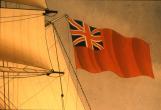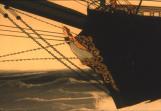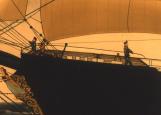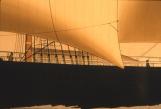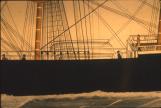15
Slide 6.7In 1817 Capt. Frederick Marryat devised a numerical code of flags which allowed merchant ship to be identified from a distance. A ship 'made its number' in order to identify itself. Passing ships made a note of the other's identity and, once in port, reported this information so that the other ship's owners could learn about its progress, as well as the date and position where the two ships met. The shipowners could then estimate their ship's arrival and have a new cargo ready for shipment.
In 1857 an international 'Commercial Code' was developed. This code, which used flags representing letters, later became the 'International Code'. Various combinations of letters could be used to identify a vessel or to make sentences such as 'Do you have a doctor onboard?' or 'My destination is Liverpool, England'.
The flags in this 'hoist' are from the 'Marryat's Code' and read: 3rd Distinguishing Pennant, 8,2,1,9. This code represents the 'Mary Durkee' and could be recognized by all who had the correct code book.
17
Slide 6.8This is the famous 'Red Duster': the flag used to denote the nationality of all British vessels. At that time Canadian vessels were also deemed to be British and so flew the 'Red Ensign'. Later a Canadian crest would sometimes be shown in the centre of the red portion of the flag to the left of the Union Jack.
19
Slide 6.9The figurehead of the 'Mary Durkee' was a female figure. This one undoubtedly represents Mary Durkee but since both the wife and daughter of the ship's owner, Amasa Durkee, was named Mary so we don't really know who this figurehead represents. Figureheads are a carryover from the ancient days when sailors painted figures or eyes on the bows of their vessels so that the vessels might see where they were going.
The chains in this illustration are supports for the bowsprit: the angled ones are the 'bobstays' and the horizontal ones the 'martingale guys'.
21
Slide 6.10The 'forecastle' (pronounced 'fo'c'sle') is the raised portion of the deck at the bow of the vessel. The word comes from medieval ships which had a 'castle' at the bow and stern from where the soldiers fought. In older ships the crew lived in the space below the 'forecastle' -that space was also called the 'forecastle'. Later on, when the crew lived in a house on the main deck this space was also called the 'forecastle'. It can be a very confusing term. In this illustration three crew members are working sails.
23
Slide 6.11The 'bowline' is the 'line' (the nautical word for a rope) attached by two smaller lines (a 'bridle') to the side of the sail - the 'bowline' keeps the sail from collapsing if the wind hits the front of the sail. Or, as de Kerchove defines it in his "International Marine Dictionary", 'Bowline: a rope attached to the leech of a sail by a bridle and leading forward. Its purpose is to steady the weather leech, and thus make the ship sail nearer the wind.'
In this illustration you can see the 'forecastle' - the house on deck where the sailors lived.
25
Slide 6.12Often when wooden ships were being built large trees for the masts were not available. In that case several pieces of wood would be put together and bound with iron hoops to form a 'built mast'. Such a mast is visible in this picture.
27
Slide 6.13In this illustration one of the ship's boats can be seen - turned upside down and lashed to the boat skids. Ships usually carried two or three boats which could be used to transfer people and goods between the ship and other vessels or the shore. They were also used for lifesaving either for rescuing crews from other ships or themselves if their own vessel had to be abandoned.
The white bands around the mast indicate that this mast was a 'built mast' - made up of several pieces of wood bound together rather than one stick of wood.
The 'ratlines' which the sailors climbed to handle the upper sails can also be clearly seen in this part of the painting.

